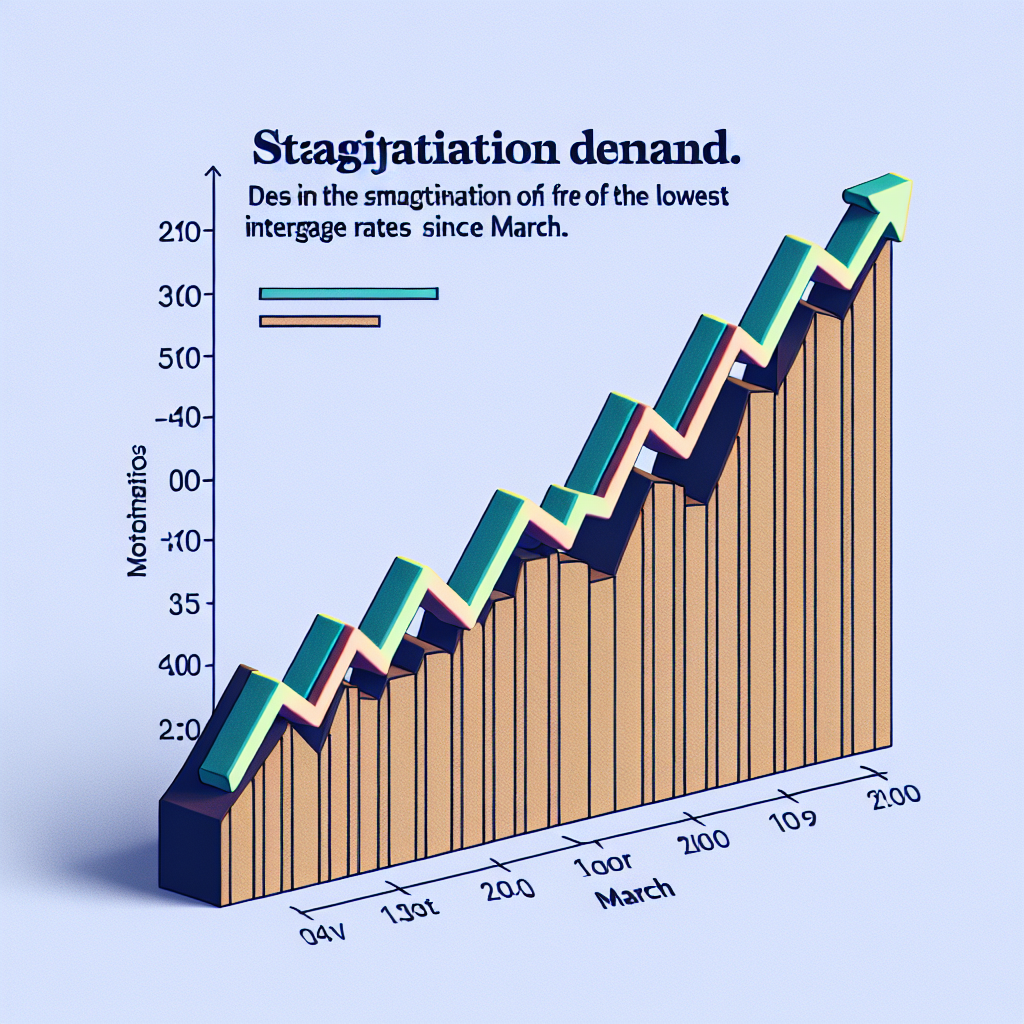-
Table of Contents
- Mortgage Demand Stagnates Despite Lowest Interest Rates Since March
- Understanding the Current Mortgage Landscape
- Historical Context
- Current Statistics
- Economic Factors
- Inflation Concerns
- Job Market Uncertainty
- Supply Chain Disruptions
- Social and Psychological Factors
- Pandemic Fatigue
- Remote Work Dynamics
- Changing Lifestyle Priorities
- Case Studies: Real-World Examples
- Case Study 1: The Smith Family
- Case Study 2: The Johnsons
- Case Study 3: The Martinez Family
- Potential Solutions and Future Outlook
- Government Intervention
- Innovative Mortgage Products
- Addressing Supply Chain Issues
- Adapting to Changing Lifestyles
- Conclusion
Mortgage Demand Stagnates Despite Lowest Interest Rates Since March

In a surprising turn of events, mortgage demand has stagnated even as interest rates have plummeted to their lowest levels since March. This phenomenon has left many industry experts scratching their heads, as lower interest rates typically spur an increase in mortgage applications. This article delves into the reasons behind this unexpected trend, examining various economic, social, and psychological factors that may be contributing to the current state of the mortgage market.
Understanding the Current Mortgage Landscape
To fully grasp why mortgage demand is stagnating, it’s essential to first understand the current mortgage landscape. As of the latest data, interest rates for 30-year fixed-rate mortgages have dropped to an average of 3.0%, the lowest since March. Historically, such low rates have been a catalyst for increased mortgage applications, as they make borrowing more affordable for potential homebuyers.
Historical Context
Historically, low interest rates have been a significant driver of mortgage demand. For instance, during the financial crisis of 2008, the Federal Reserve slashed interest rates to near-zero levels, leading to a surge in mortgage refinancing and new home purchases. Similarly, in the early months of the COVID-19 pandemic, the Fed’s decision to lower rates resulted in a boom in mortgage applications.
Current Statistics
Despite the favorable interest rates, recent statistics paint a different picture:
- Mortgage applications have decreased by 2% compared to the previous month.
- Refinancing applications have dropped by 5%.
- New home purchase applications have remained flat.
These numbers indicate a clear stagnation in mortgage demand, prompting a deeper investigation into the underlying causes.
Economic Factors
Several economic factors are contributing to the stagnation in mortgage demand, despite the low interest rates.
Inflation Concerns
One of the primary economic factors at play is the rising concern over inflation. As inflation rates climb, consumers’ purchasing power diminishes, making it more challenging for potential homebuyers to afford new properties. Additionally, higher inflation often leads to increased costs for goods and services, further straining household budgets.
Job Market Uncertainty
The job market remains another critical factor. While unemployment rates have improved since the height of the pandemic, job market uncertainty persists. Many individuals are hesitant to make significant financial commitments, such as purchasing a home, due to concerns about job stability and future income prospects.
Supply Chain Disruptions
Supply chain disruptions have also played a role in the stagnation of mortgage demand. The construction industry has been hit hard by shortages of essential materials, leading to delays in new home construction. As a result, the inventory of available homes remains low, limiting options for potential buyers.
Social and Psychological Factors
Beyond economic considerations, social and psychological factors are also influencing mortgage demand.
Pandemic Fatigue
Pandemic fatigue is a real phenomenon affecting many individuals. After more than a year of dealing with the uncertainties and challenges brought about by COVID-19, many people are experiencing decision fatigue. This mental exhaustion can lead to a reluctance to make significant life changes, such as purchasing a new home.
Remote Work Dynamics
The shift to remote work has also had a profound impact on the housing market. While some individuals have taken advantage of remote work to relocate to more affordable areas, others remain uncertain about the long-term viability of remote work arrangements. This uncertainty can lead to hesitation in committing to a new mortgage.
Changing Lifestyle Priorities
The pandemic has prompted many individuals to reevaluate their lifestyle priorities. For some, this has meant placing a greater emphasis on experiences and personal well-being over material possessions. As a result, the desire to purchase a new home may not be as strong as it once was.
Case Studies: Real-World Examples
To illustrate the impact of these factors, let’s examine a few real-world examples.
Case Study 1: The Smith Family
The Smith family, a middle-class household living in a suburban area, had been planning to purchase a new home in early 2021. However, concerns about job stability and rising inflation led them to postpone their plans. Despite the attractive interest rates, they decided to focus on building their savings and paying down existing debt.
Case Study 2: The Johnsons
The Johnsons, a young couple working remotely, initially considered relocating to a more affordable city. However, uncertainty about the long-term feasibility of remote work arrangements made them hesitant to commit to a new mortgage. Instead, they opted to continue renting until they had more clarity about their work situation.
Case Study 3: The Martinez Family
The Martinez family, who had been living in a small apartment in a densely populated urban area, decided to prioritize their mental well-being over purchasing a new home. They chose to invest in experiences, such as travel and personal development, rather than taking on the financial burden of a mortgage.
Potential Solutions and Future Outlook
While the current stagnation in mortgage demand presents challenges, there are potential solutions and a hopeful future outlook.
Government Intervention
Government intervention can play a crucial role in addressing some of the economic factors contributing to stagnation. For example, targeted stimulus packages and incentives for first-time homebuyers could help alleviate financial pressures and encourage more individuals to enter the housing market.
Innovative Mortgage Products
Financial institutions can also contribute by offering innovative mortgage products tailored to the current economic climate. Flexible mortgage terms, lower down payment options, and programs for individuals with non-traditional income sources could make homeownership more accessible.
Addressing Supply Chain Issues
Efforts to address supply chain disruptions in the construction industry are essential. By ensuring a steady supply of building materials and streamlining construction processes, the inventory of available homes can be increased, providing more options for potential buyers.
Adapting to Changing Lifestyles
Recognizing and adapting to changing lifestyle priorities is also crucial. Real estate developers and agents can focus on creating properties that align with the evolving needs and preferences of buyers, such as homes with dedicated office spaces for remote work or properties in areas with a strong emphasis on community and well-being.
Conclusion
In conclusion, the stagnation in mortgage demand despite the lowest interest rates since March is a multifaceted issue influenced by a combination of economic, social, and psychological factors. Rising inflation, job market uncertainty, supply chain disruptions, pandemic fatigue, remote work dynamics, and changing lifestyle priorities all play a role in shaping the current mortgage landscape.
While the challenges are significant, there are potential solutions that can help stimulate mortgage demand. Government intervention, innovative mortgage products, efforts to address supply chain issues, and adapting to changing lifestyles are all steps that can be taken to encourage more individuals to enter the housing market.
As we move forward, it will be essential for industry stakeholders to remain adaptable and responsive to the evolving needs and concerns of potential homebuyers. By doing so, we can work towards a more robust and resilient mortgage market that benefits both consumers and the broader economy.








